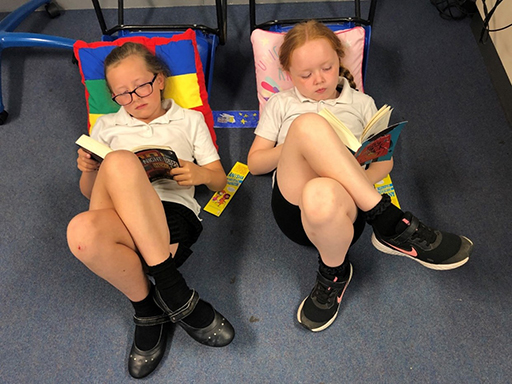4 Independent reading: time to read
Intuitively it makes sense that time spent practising a skill will lead to improvement. It also makes sense that in order to help young readers develop their stamina and extend their reading miles, time needs to be set aside in school. This is particularly important when recognising the reality that many young people don’t choose to read at home, and may not be being read to there. Providing time and space to read in class is a core element of an effective RfP pedagogy (Cremin et al., 2014).

Independent reading should be accompanied by the three other strands of RfP pedagogy and supported by teacher knowledge of texts and readers to ensure it doesn’t become devoid of authentic reader engagement and interaction.
Having said this, internationally, the value of independent reading in school has been debated. Over 20 years ago, the National Reading Panel in the US asserted that the research base was insufficient to support the use of independent reading in classrooms (National Institute of Child Health and Human Development, 2000). Concerns about the impact on comprehension and whether some children might be ‘fake reading’ or choosing particularly easy, non-challenging texts have been voiced and consequently the time assigned to choice-led reading in school has been eroded. But demeaning reading behaviours such as choosing easy texts is unhelpful; adults, too, often choose ‘easy’ texts according to their purpose, such as perusing recipes, magazines and newspapers.
Personal reflection 1
Take a moment to reflect on some of your recent reading choices.
Do you choose only to read longer, harder, fatter books or simply what you wish to read according to your current purpose?
Discussion
To support children’s RfP, you need to let them exercise their rights as readers to choose what they want to read, not impose hierarchies and more demanding books or castigate them for engaging as ‘fake readers’!
Nonetheless, focused professional attention and informed support for text choice and reading time is needed. If you think a child is pretending to read, even when they are able to then, as discussed in Session 3, get to know your reader and find texts that have relevance for them. More guidance is offered in Section 9.
Recent research indicates that reading time can foster engagement and motivation and nurture a love of reading (Moses and Kelly, 2019). Through closely observing 6-7-year-old’s reading behaviours, these researchers found that when children are supported by an informed practitioner and wider RfP pedagogy, their engagement during this time developed their capacities as meaning makers.
Other research shows that when children read silently at their own pace, they read and comprehend up to 30% more than they would if they were required to read aloud to their teacher (Hiebert, Wilson and Trainin, 2010). A meta-analysis of vocabulary research also reveals that child-led ‘free reading’ is 12 times more effective at widening vocabulary in the long term compared to explicit instruction (McQuillan, 2019).
Independent reading has value for all young readers: those in the early stages, those struggling, those reading in their second language, and even those more assured (Hudson and Williams, 2015). However, to build, motivate and sustain the habit of reading children need significant support. You will look at this in more detail next.
